Group seeks compensation to save the Creston Valley Wildlife Management Area
By Suzy Hamilton, The Nelson Daily
Northern leopard frogs aren’t the only endangered species at the Creston Valley Wildlife Management Area (CVWMA).
Adequate funding is also becoming scarce, thanks to a move by the BC government, placing the management of the 7,000 hectare wetlands, educational programs and interpretative centre at risk.
Now, several Nelson area residents from the West Arm Outdoors Club are part of a group of concerned citizens called New Futures for the CVWMA whose aim is to secure monies to keep it operating permanently.
“The ultimate disaster is that there would be no funding and the marshes would revert to low land forests,” said Procter resident Rick Morley.
Morley is the author of the September, 2013 report, “CVWMA, “The Case for Compensation”.
In it, he makes the case for Columbia Basin Trust and BC Hydro to supply permanent funding of $1million annually in compensation for the loss of the natural wetlands that occurred when dams — mainly the Libby Dam in Montana — was created by the Columbia River Treaty in the 1960s.
No longer a natural wetland, the CVWMA is maintained artificially with asystem of dykes, control structures and pumps installed in the early 70’s to create a series of managed wetland compartments to manage flood and drought cycles.
“The system was designed to enhance wildlife production and prevent the loss of wildlife use that would otherwise occur because of the changed management of the Kootenay River system for hydroelectric power generation and flood control,” Morley wrote in his report.
Funding for this costly endeavor has always been precarious, even with sizeable donations, a RAMSAR wetlands of international significance designation in 1994 and an annual grant from BC Hydro that has grown to nearly $400,000.
But last spring the BC government may have rung the death knell. It rescinded the Creston Valley Wildlife Management Area Act and turned the area into a Wildlife Management Area (WMA).
“There are many such designated areas (WMA’s) in the Province and the Creston wetlands would become one of that number,” said Morley.
“Typically, these WMA’s have no management plans and little or no funding dedicated to them.
“This decision by the provincial government was taken without any public information being disseminated; without any public discussion and disappointingly, without input from concerned citizens.”
According to Morley’s report, the provincial government has contracted Ducks Unlimited (DU), to operate the area, with present staff becoming employees of DU.
“They do a fine job, but Ducks Unlimited are concerned only with ducks,” he said. “They are not concerned with badgers, or grizzlies, or even owls for that matter.”
The new management would be under the jurisdiction of the Ministry of Forests, Lands and Natural Resources Operations. There would be no commitment to public involvement in the Area’s management and protection, Morley said.
“WMA’s offer very minimal protection against change to their status and can be altered by a simple ‘Order in Council’. Parts of the existing area could be carved off and sold or otherwise alienated with minimal effort,” said Morley in his report.
The CVWMA has had a reprieve, however. The May 2013 provincial election prevented the existing government from passing the rescinding legislation that would have extinguished the CVWMA Act.
“There are dozens of agreements in the province that compensate for impacts to other B.C. habitats,” said Morley.
“For example, the highly impacted Kootenay Lake ecosystem is fertilized annually by a multimillion dollar compensation program which began in the early 1990’s but does not provide compensation for the CVWMA.”
“The ecosystem of the CVWMA is being severely impacted by the same dam that impacts a large part of Kootenay Lake.”
The CVWMA attracts over 35,000 visitors per year from around the world — a far cry from when David Thompson in 1807 described it as a mosquito infested “swamp” that almost destroyed his horses and men.
More than 300 bird species, 60 mammals, 17 fish, six reptile and six amphibian species are dependant on this wetland habitat that provides an important waterfowl migratory corridor.
“The provincial government should ‘broker’ a compensation package sufficient to provide for the ongoing requirements of the CVWMA,” Morley’s report concluded.
“These requirements should include the operation of the visitor centre, the offices and staff support as well as ongoing maintenance and operation. This negotiation should take place with all the downstream beneficiaries of the Libby Dam.”
And as for the fate of the endangered northern leopard frog, a beautiful, medium-sized amphibian, its breeding grounds are restricted to two areas in the province, one of them the CVWMA.
Its future is threatened by the loss of wetland habitat as a result of human development, pollution, disease, and the introduction of non-native species.
The question is, said Morley, will the CVWMA face the same fate.






















